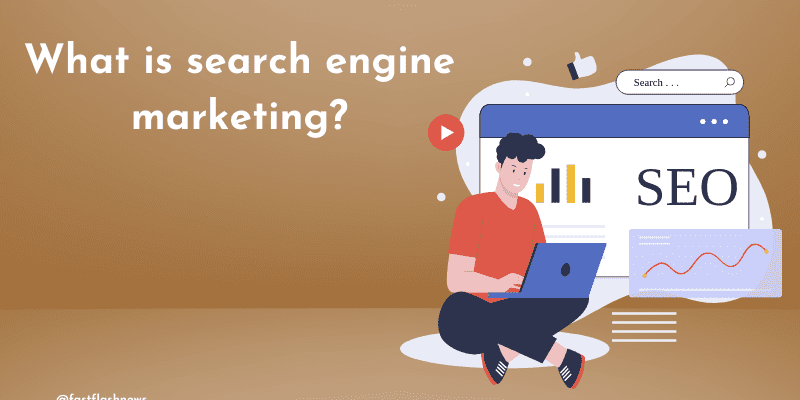Search engine marketing
- Search engine marketing (SEM) is a digital marketing technique that involves increasing a website’s exposure in search engine results pages (SERPs).
- While the industry term once applied to both organic and paid search activities, such as search engine optimization (SEO), it now almost exclusively refers to paid search ads.
- Search engine marketing is sometimes known as sponsored search or pay-per-click.
Why is SEM important?
- With a rising number of people researching and purchasing things online, search engine marketing has become a critical online marketing method for expanding a company’s reach.
- In reality, the vast majority of new visitors to a website arrive from a search engine query.
- Advertisers in search engine marketing only pay for impressions that lead to visitors, making it an effective method for a business to spend its marketing budget. As an extra advantage, each visitor helps the website’s rating in organic search results.
- Consumers are more likely to make a purchase when they submit search queries with the aim of discovering commercial information, as opposed to other sites like social media where users are not specifically seeking for something.
- Search marketing targets customers at the optimal moment: when they are open to fresh information. PPC advertising, unlike the bulk of digital advertising, is not invasive and does not interfere with users’ duties.
- SEM yields immediate results. It is perhaps the quickest technique to attract visitors to a website.
How SEM works
- Search engines employ complex algorithms to deliver the most relevant results for each query, incorporating location and other accessible information.
- Sponsored advertisements appear at the top and sides of search engine results pages, increasing exposure and prominence over organic results.
- Assume you’re a customer searching for a product or service online. You go to a search engine and enter your search phrases (also called keywords).
- On the search results page, you will see many firm adverts whose keywords match the terms in your search.
- These adverts display prominently on the page, among other search results that match your criteria. The sponsored listings are very relevant to your exact search, so you’re likely to click on them.
- Now, let’s look at how SEM campaigns function from a marketer’s standpoint.
- SEM networks are self-service operations. Once a marketer has decided on a network, he or she may launch a campaign quickly.
- When creating a campaign on a SEM network, the marketer is asked to:
- Conduct keyword research and choose a set of keywords relevant to their website or product.
- Select a geographic location for the ad to be shown in.
- Create a text-based ad that will appear in the search results.
- Bid the amount they are ready to spend for each click on their ad.
- Text-only advertisements are straightforward to create. Marketers add a headline, ad body content, a call-to-action, and a hyperlink URL.
- Many believe that search engine marketing is the most effective method to spend marketing money.
Examples of search ad networks
- SEM specialists focus on two key search networks: Google Ads (previously Google Adwords) and Bing Ads.
- Google AdWords consists of two networks: Google Search Network and Google Display Network. The first network only contains Google-owned search-related websites, but the second includes YouTube, Blogger, and Gmail. Customers may use Bing advertisements to purchase advertisements on both Yahoo’s and Bing’s websites.
- While Google Ads is a much larger network (about twice the size), Bing Ads price is frequently lower. Marketers may be able to achieve a higher ranking for a competitive search term for less than they do on Google. Some claim that clickthrough rates are also greater.
How A/B testing can complement SEM
- Because you are currently investing in search engine marketing to drive traffic to your website, it is beneficial to optimize that traffic for conversions and maximize the effectiveness of your spending.
- A/B testing your landing pages is a simple approach to maximize your investment, whether by optimizing for average order value or revenue per page.
- Optimizing your landing page will help you improve your Quality Score on search engine marketing networks, lowering your average CPC.
- Optimizely, and other similar tools, can help you effortlessly create and conduct A/B testing, providing real-time data to give you confidence in your business decisions. Optimizely integrates with key ad networks like Google Adwords and Facebook, making it quick and straightforward to set up ad-related trials.
FAQs
What is SEM (Search Engine Marketing)?
Search Engine Marketing (SEM) is a digital marketing approach that focuses on paid advertising to boost a website’s exposure in search engine results pages (SERPs).
How is SEM different from SEO?
SEM (Search Engine Marketing) employs paid advertising to appear in search results, whereas SEO (Search Engine Optimization) focuses on optimizing website content to rank higher naturally without using ads.
What are the advantages of employing SEM in digital marketing?
SEM may deliver rapid visibility, targeted advertising, measurable outcomes, and improved website traffic, making it a valuable tool for boosting sales and leads.
What are the key components of a SEM campaign?
Keyword research, ad creation and optimization, budget and bid setup, and ongoing analysis and adjustment of campaigns for improved performance are all important components of a SEM campaign.




